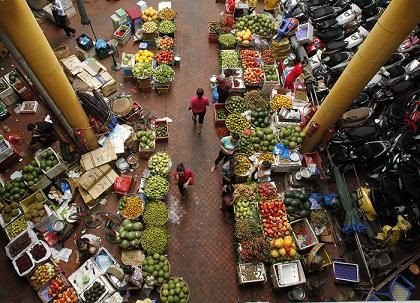Vietnam's Economy: Stimulus A 'Sugar High' That Won't Last Or Fix The Banking Problem

Vietnam, the Southeast Asian country viewed by many foreign investors as the mini-China, reported stronger growth for the second quarter on Thursday. But there’s nothing worth celebrating.
Vietnam’s statistical office said gross domestic product grew by 5 percent between April and June, up from 4.9 percent in the first quarter. However, the pick-up in growth from the first quarter does not mean that underlying conditions are improving.
Even taking the data at face value, they show that Vietnam is on track to grow by about 5 percent this year, which would be unchanged from last year. This compares with average growth over the past two decades of around 7.5 percent a year. The government has targeted economic growth of 5.5 percent for 2013.
Moreover, the uptick in the growth rate is more or less the product of a looser monetary-policy stance.
Vietnam’s central bank has cut its lending rate eight times (by a cumulative 800 basis points) in little more than a year as it has looked to spur bank lending and boost consumption after economic growth had fallen to a 13-year low of 5.03 percent in 2012. The refinancing rate is now at 7 percent and analysts at Standard Chartered are looking for another rate cut of 50 basis points -- to 6.5 percent -- next quarter if policymakers remain comfortable with the inflation outlook.
Vietnam is struggling with a host of economic woes, including sluggish domestic demand, a banking sector weighed down with high levels of toxic debt and record numbers of bankruptcies. But rate cuts alone will not rescue the economy. By pursuing a stimulus strategy, Vietnam aggravates long-term problems. It's akin to giving the country, and the markets, a sugar high. It may cause a jolt of activity, but that will be replaced by the reality that the underlying problems aren't being addressed.
Vietnam's inflation hit 6.69 percent year-on-year in June, official figures showed Tuesday, marking the first increase in eight months after the government cut interest rates. That’s up from 6.35 percent in May. The government has an official inflation target of about 8 percent this year but it has hoped to keep it between 6 percent and 6.5 percent.
The main cause of the slowdown has been problems in the banking sector. As Capital Economics pointed out in a note, nonperforming loans have risen sharply, and the country is now experiencing a severe credit crunch. Credit is now growing in single figures for the year-ago period, and below the pace of nominal GDP growth.
The authorities are trying to clean-up the banking system. Earlier this year, the government announced it would be setting up a debt asset management company to take over bad loans from indebted banks. The “bad bank,” or the Vietnam Asset Management Company, will be a 100 percent state-owned company whose aim, according to the central bank, is to “solve the bad debts and promote reasonable credit growth in the economy.”
But key questions remain about where the money will come from, whether a company with 500 billion dong ($24 million) will be able to unravel bad debts of hundreds of trillions of dong in the banking system, and how to implement it.
The central bank said the VAMC would buy bad debts with its own capital or through the issue of “special bonds,” which will pay no interest and may be used to obtain refinancing loans from the central bank. Economists, however, remain skeptical about the plan. The trick that makes all books look beautiful is attractive for now, but is just a very short-term solution.
“Until the banking sector is fixed and credit starts to flow more freely, growth is likely to remain subdued,” Gareth Leather, an economist with Capital Economics, said in a note.
Recently, the IMF cut its 2013 GDP growth forecast for Vietnam to 5.2 percent from 5.8 percent and highlighted the need for the government to follow through on reforms. Earlier this month, HSBC also slashed Vietnam’s GDP growth forecast for this year from 5.5 percent to 5.1 percent.
While problems in the banking sector will continue to weigh on the economy, there are some encouraging signs. The export sector is continuing to perform well. Exports in the first half rose 16.1 percent to $62.05 billion from the same period a year earlier, while imports climbed 17.4 percent to $63.5 billion for a trade deficit of $1.4 billion, the Statistics Office said Thursday.
“Increasingly, this is not only in low-end goods such as textiles, but also in higher value-added sectors, such as in the assembly of electronic consumer items,” Leather said, adding that exports should continue to grow at a decent pace over the next couple of years despite the likelihood that global demand will remain weak.
© Copyright IBTimes 2025. All rights reserved.





















